Pechan Prism
The Pechan prism performs much like the Dove prism, but it may be placed in convergent or divergent light, permitting a reduction of instrument size. It will invert (shown here) or revert the image, depending on its orientation. It may also displace the line of sight if not properly centered, but will not deviate it. the Pechan prism may be used for image rotation and derotation.
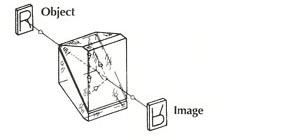 |
 |
Dove Prism
This direct-vision prism is made in one piece. The image will be inverted when the prism is held as shown in the figure, and is inverted when the prism is turned about the axis through an angle of 90°. It can only be used in parallel light.
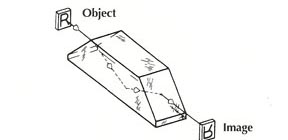 |
ABBE Prism, Type A
This prism inverts and reverts the image, but will not deviate the line of sight. As a result, it is a direct-vision prism. It is two pieces cemented together.
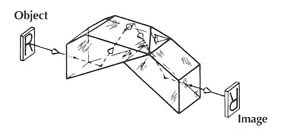 |
Reversion Prism
This prism, a modification of the Abbe prism type A, is made up of two elements which are cemented together. Like the Pechan prism, it may be placed in the path of parallel, converging, or diverging beams oflight. Because three reflections are involved, it may be used to revert (a) or invert (b) the image, depending on its orientation.
 |
Schmidt Prism
The Schmidt prism will revert and invert the image, and at the same time, it will deviate the line of sight through an angel δ = 45°.
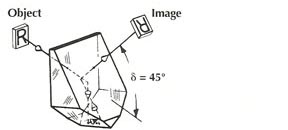 |
Right-Angle Prism
his single prism will deviate the line of sight through an angle δ = 90°. The image will be inverted when the prism is turned through an angle of 90°, as shown in (b).
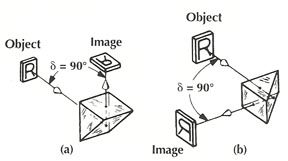 |
Porro Prism System
In 1850, an Italian engineer named Porro designed the prism system here. This prism is made up of two right-angle prisms, usually identical in construction, placed at right angles to each other. It is a direct-vision prism system, but the axis is desplaced by the amount d. The system will invert and revert the image.
 |
Penta Prism
This prism will neither revert nor invert the image, but will simply deviate the line of sight through a 909° angle.
 |
Amici Prism
The amici prism will revert and invert the image, and at the same time, will deviate the line of sight through an angle δ to 90°.
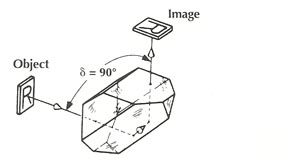 |
Delta Prism
This prism is a compact folded version of the traditional Dove prism. It is made of high-index glass (n>1.7); the base only is silvered. The delta prism is used primarily for image rotation and derotation.
 |
| Portions of the above material were extracted from the Military Handbook-141, released in 1962 by the Dept. of Defense, and an excellent reference on optical theory and design. |
